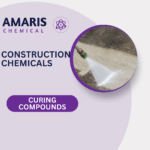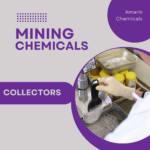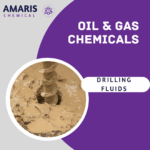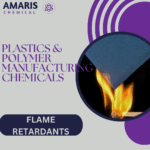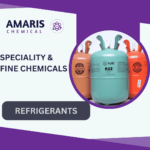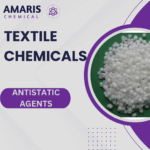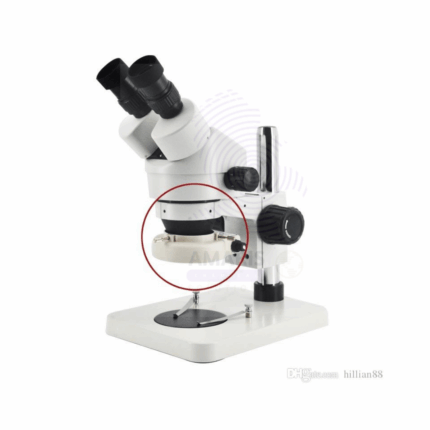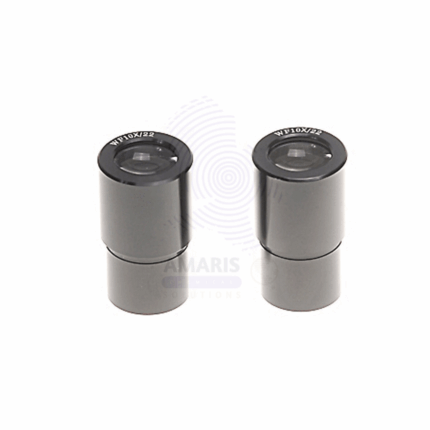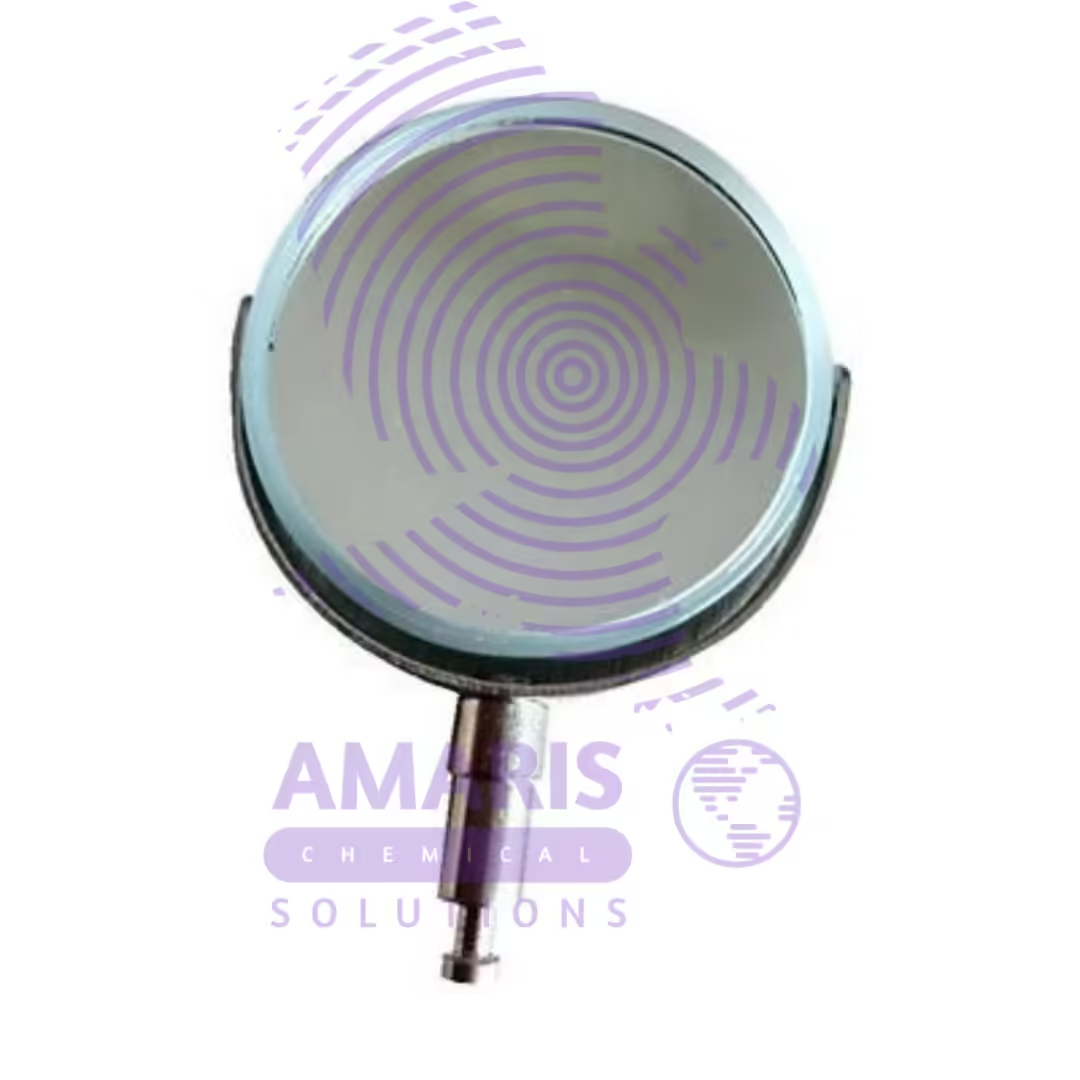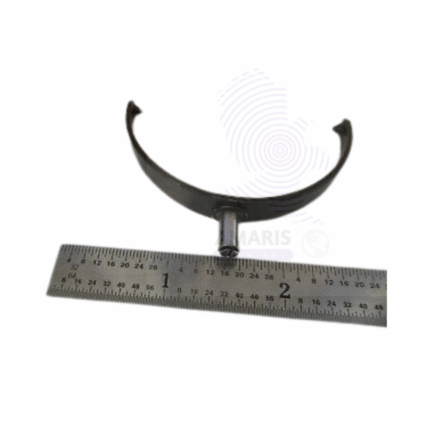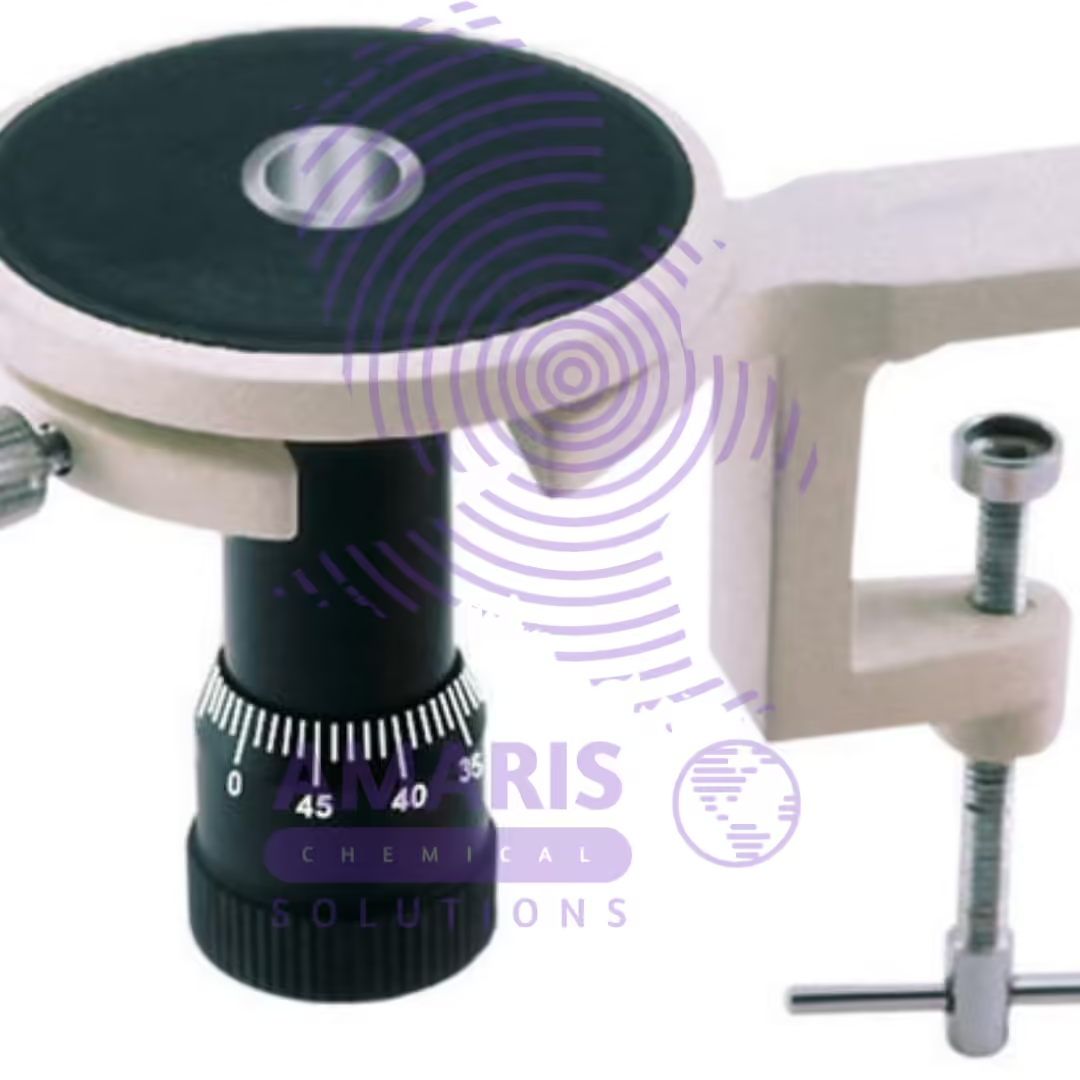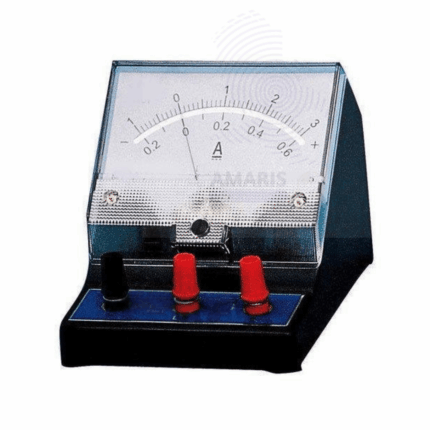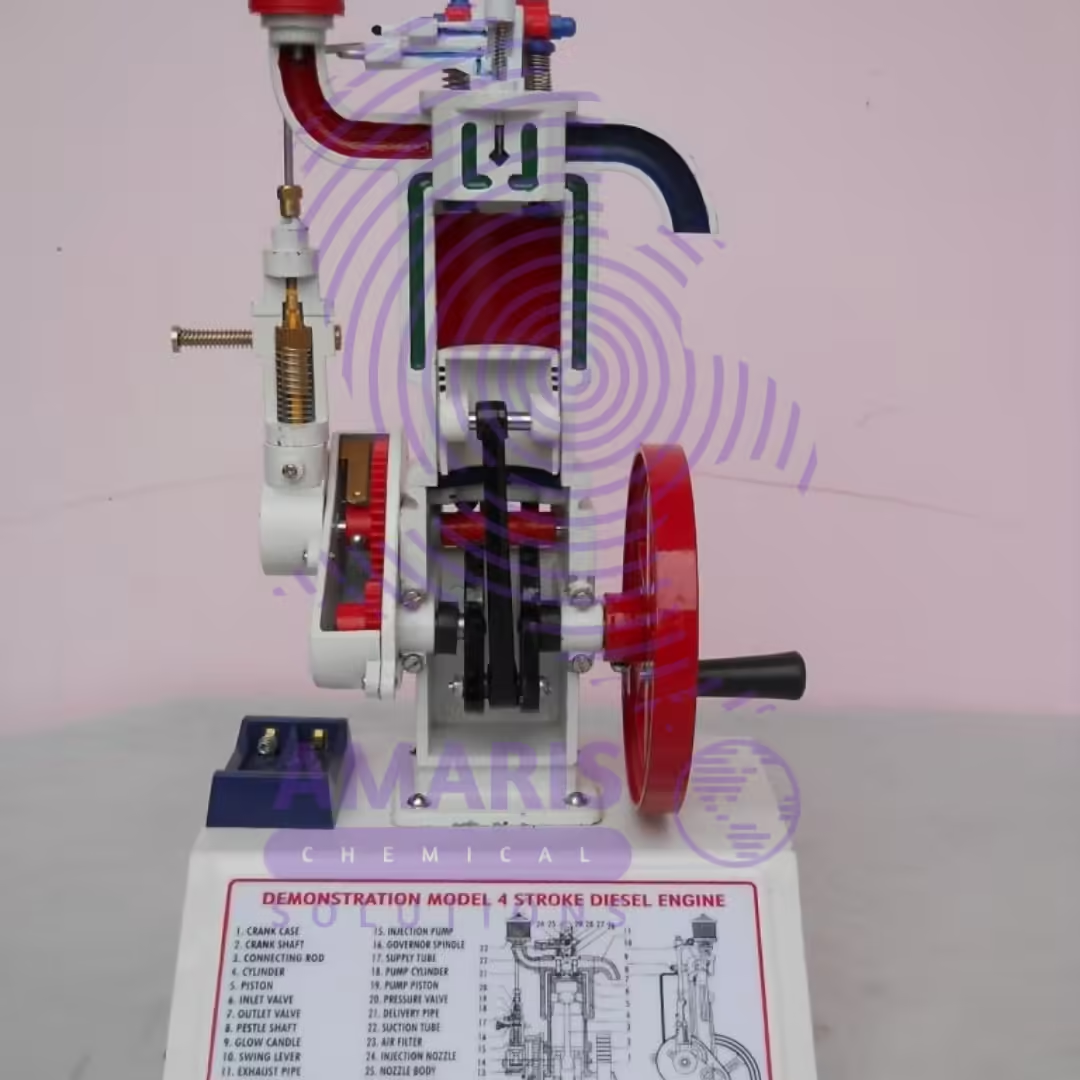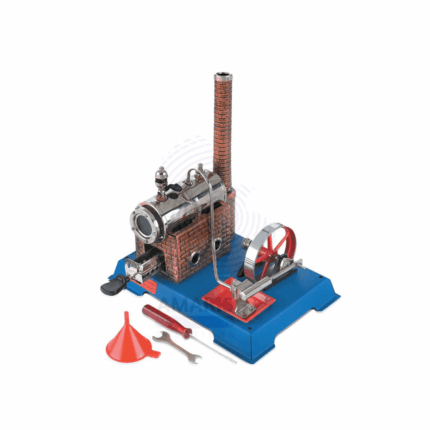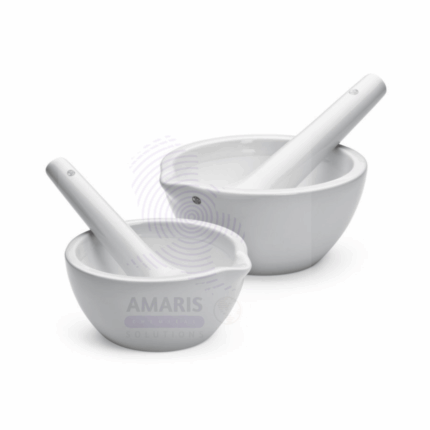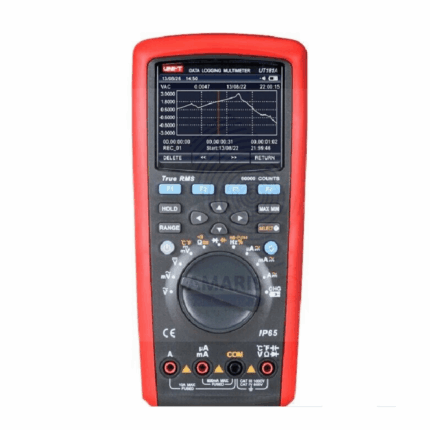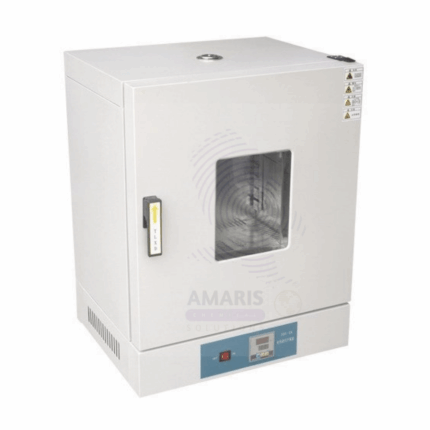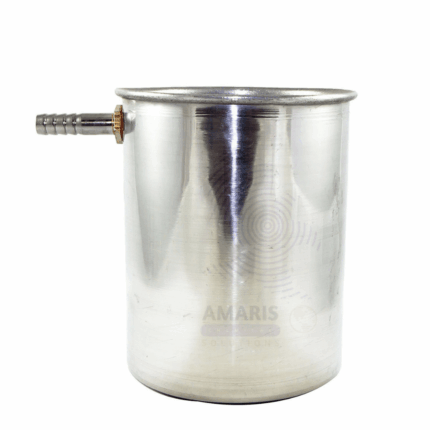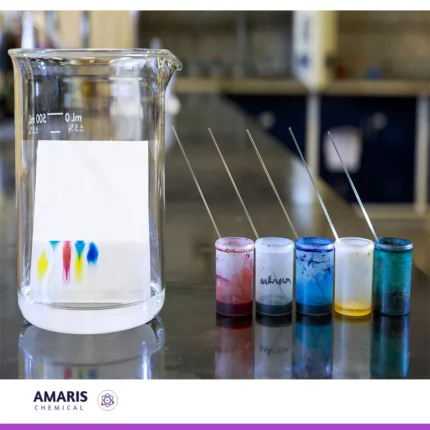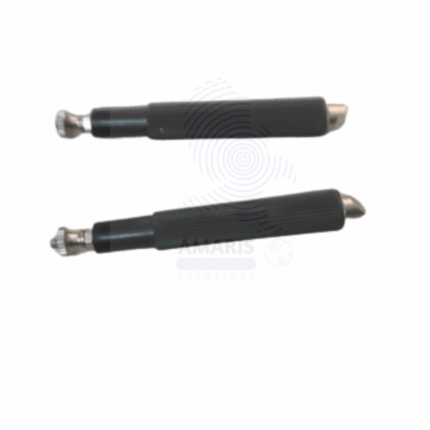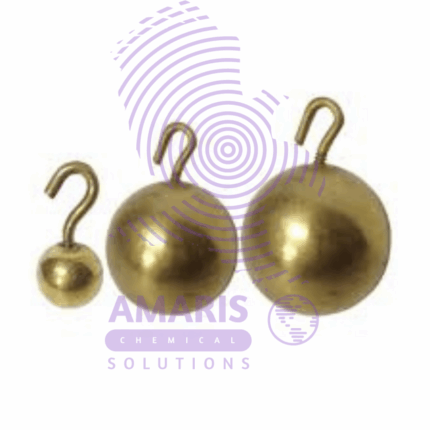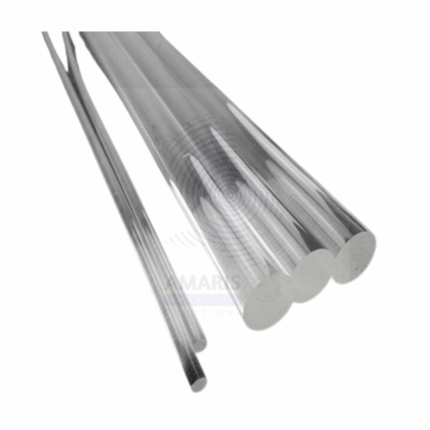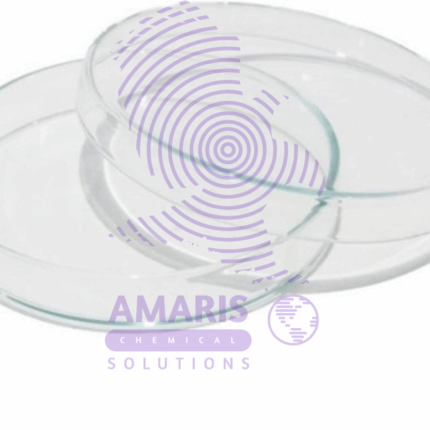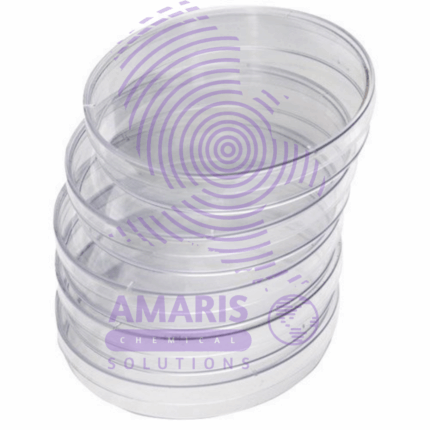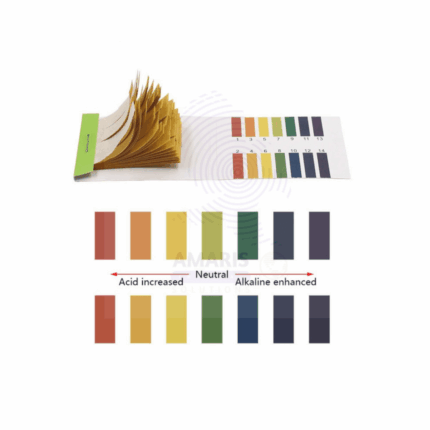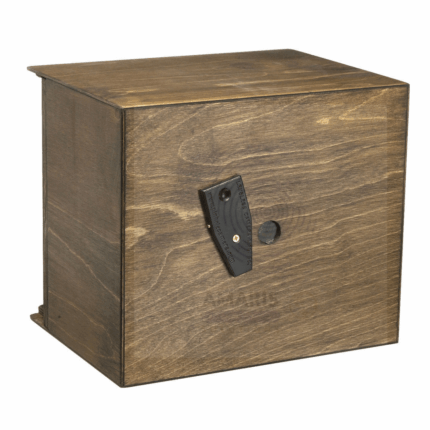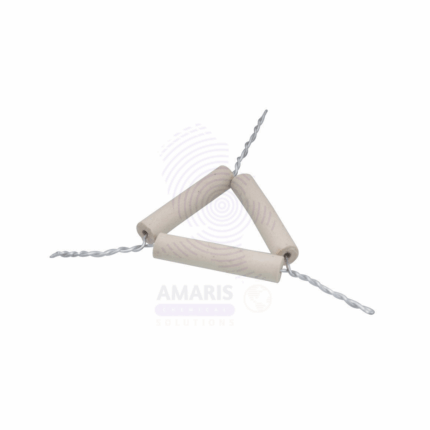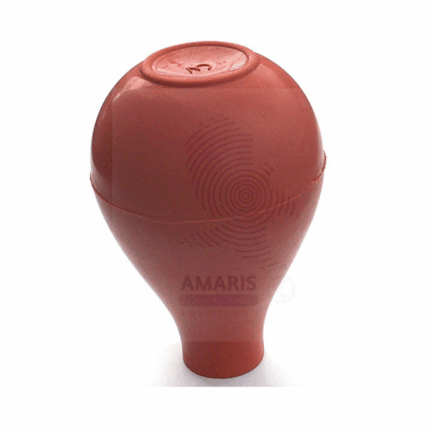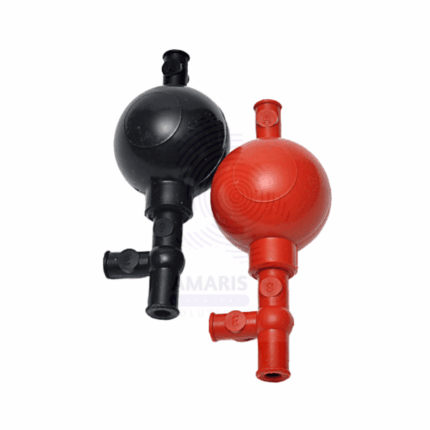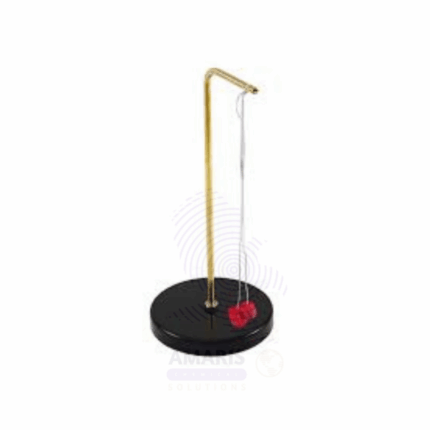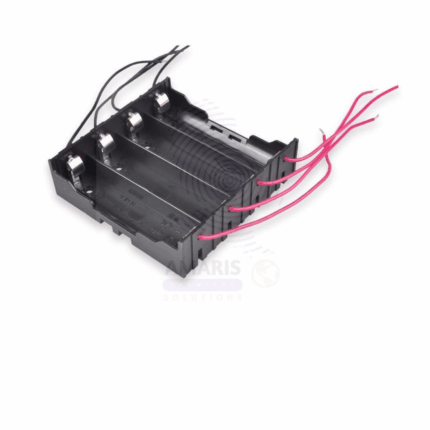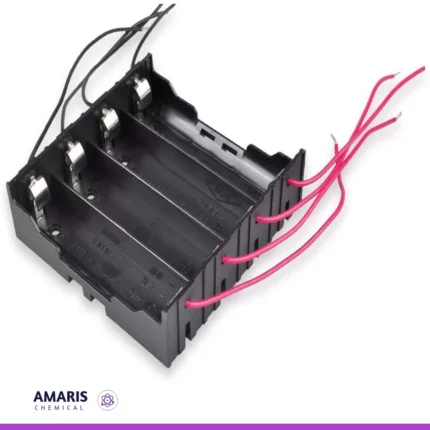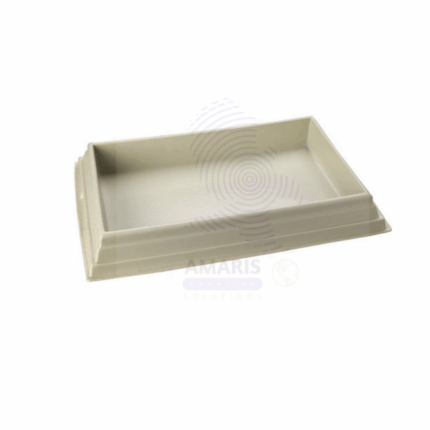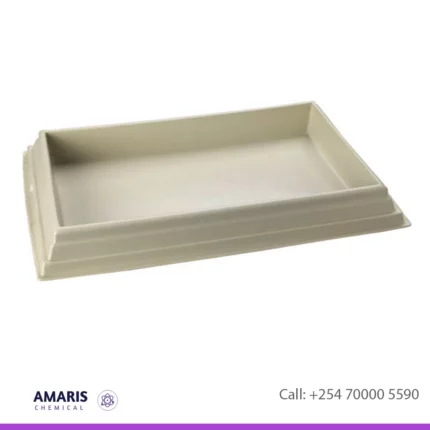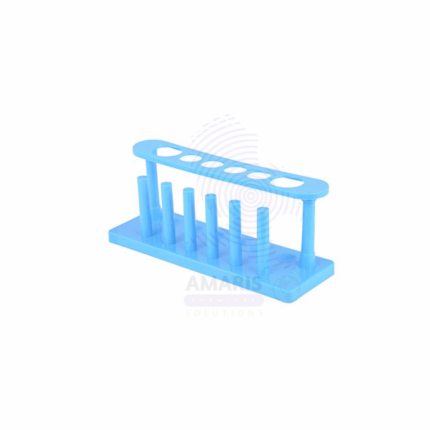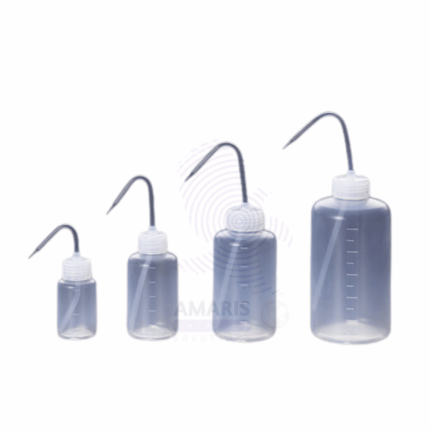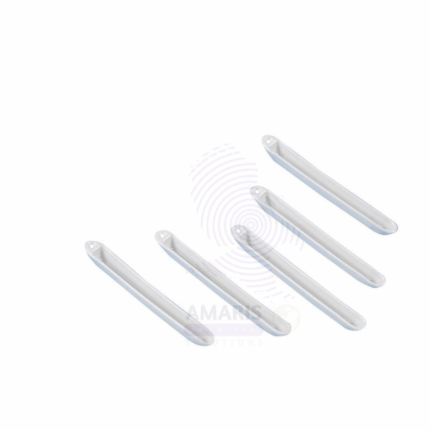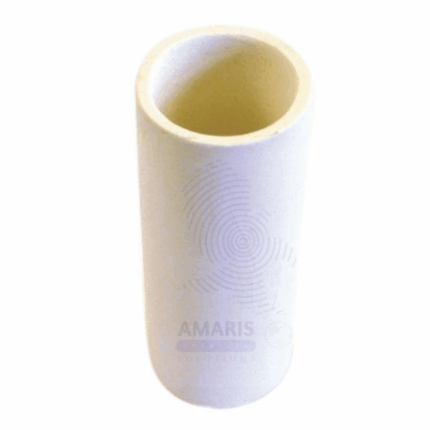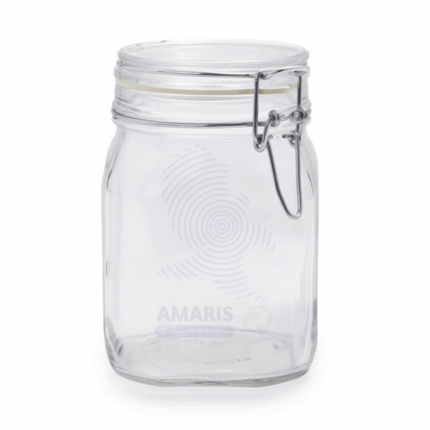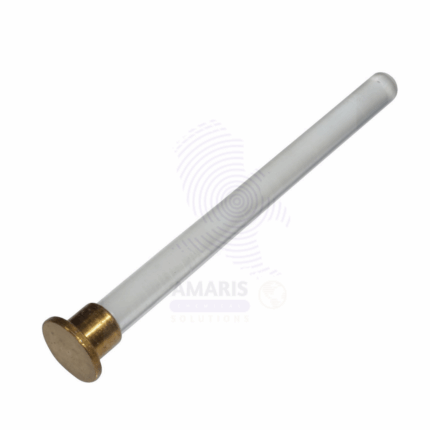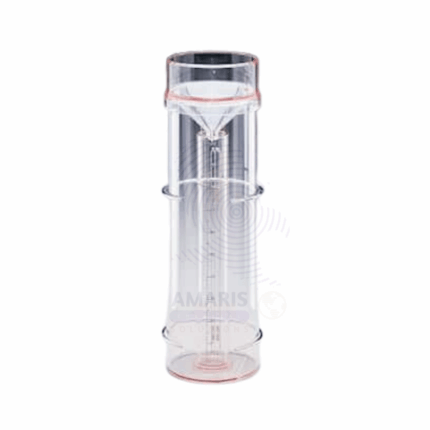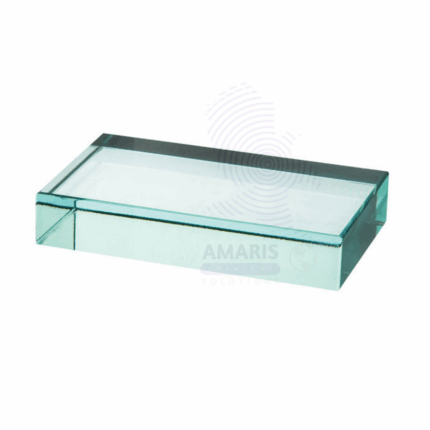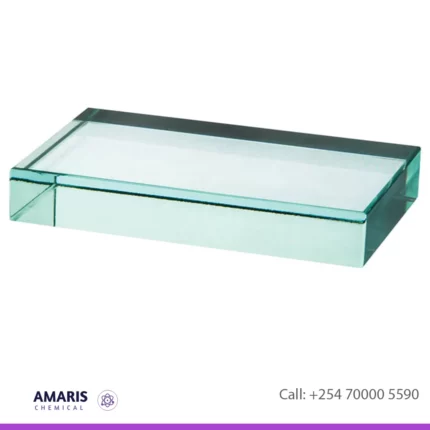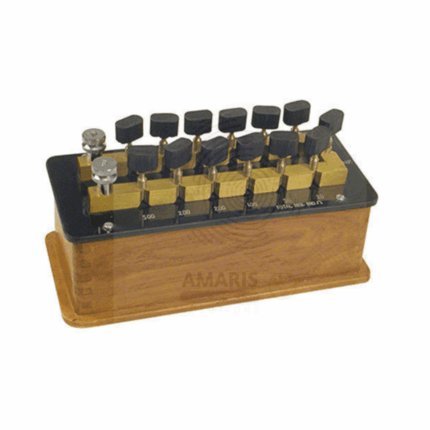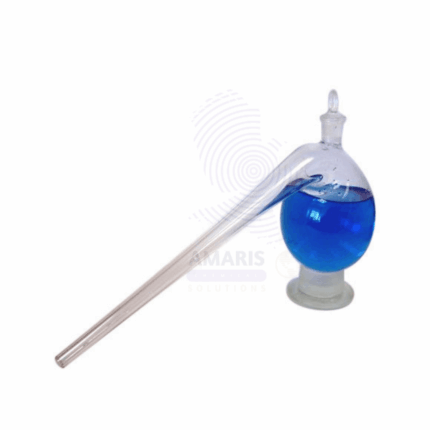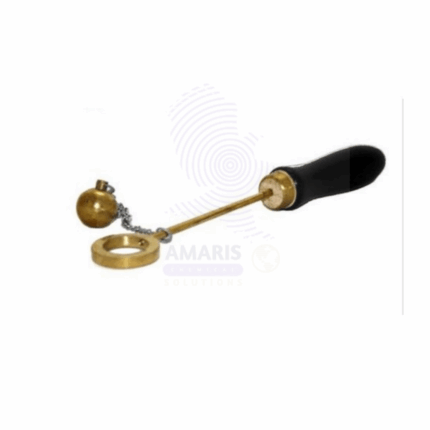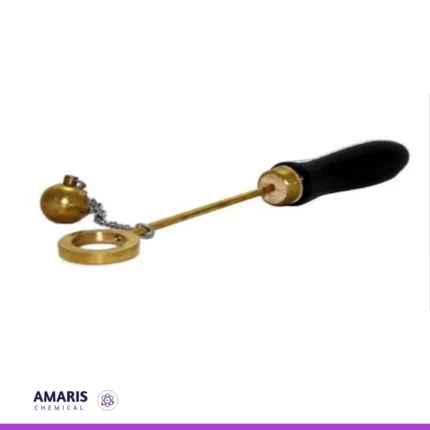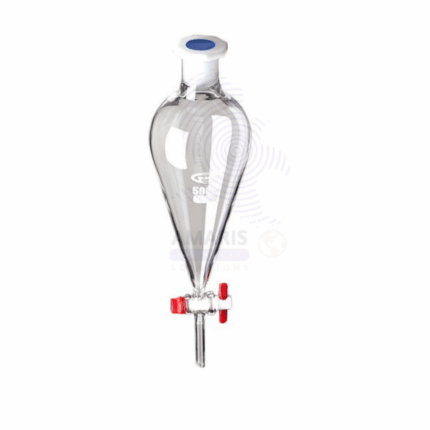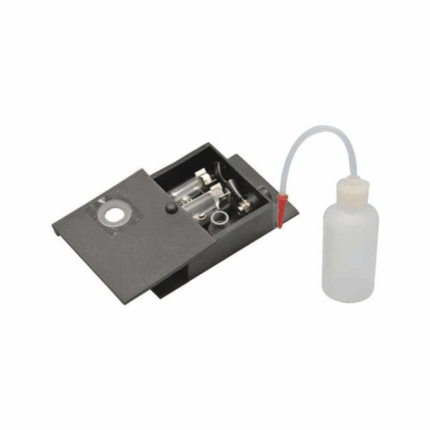Mercury thermometer
A mercury thermometer is a precise temperature-measuring device consisting of a sealed glass tube filled with mercury, which expands and contracts in response to temperature changes. Known for its accuracy, this thermometer typically measures temperatures ranging from approximately -39°C (-38.8°F) to 356°C (672.8°F). The glass tube is calibrated with a scale marked in degrees Celsius or Fahrenheit, allowing for easy reading of the temperature via the distinct silver meniscus formed by the mercury. Although durable and resistant to certain chemicals, mercury thermometers pose environmental and health risks due to the toxic nature of mercury, leading many laboratories and institutions to transition to safer alternatives. Despite this shift, their reliable performance and consistent readings have made them a long-standing tool in scientific, medical, and industrial applications.
Microscope
A microscope is an optical instrument that magnifies tiny objects or organisms, allowing for detailed observation of structures that are too small to be seen by the naked eye. It typically uses a combination of lenses to enlarge the image, with modern variations including light microscopes for basic magnification and electron microscopes for highly detailed, atomic-level imaging. Microscopes are fundamental tools in scientific research, medical diagnostics, and quality control across fields such as biology, chemistry, materials science, and forensics.
Microscope condenser
A microscope condenser is a device located beneath the stage of a microscope that gathers and focuses light from the microscope's illumination source onto the specimen. Its primary function is to enhance the clarity, brightness, and contrast of the image by adjusting the concentration and direction of light. The condenser often includes an adjustable diaphragm, which regulates the intensity of light and can be fine-tuned to optimize resolution and contrast for different types of specimens and magnifications. It is essential for achieving high-quality, detailed observations in both basic and advanced microscopy technique
Microscope cover slips
A microscope cover slip is a thin, flat piece of transparent glass or plastic placed over a specimen on a microscope slide. Its primary function is to protect the specimen and enhance the clarity of the microscopic image by reducing light refraction. The cover slip also helps flatten liquid or soft samples, creating a uniform surface for improved focus, while preventing evaporation and contamination. This essential tool ensures accurate observation, especially at high magnifications, and can be used for both temporary and long-term preservation of samples
Microscope cover slips
Microscope eye piece
The microscope eyepiece, also called the ocular lens, is the lens through which you view the magnified image of a specimen. Positioned at the top of the microscope, it typically provides an additional magnification of 10x or 15x, complementing the magnification of the objective lens. The eyepiece allows the user to fine-tune focus, align the eye with the light path for clearer viewing, and sometimes includes a reticle for measuring specimens. It's a critical component that transforms the detailed image created by the objective into one that can be effectively observed.
Microscope mirror
A microscope mirror is a polished reflective surface typically made of glass or metal that is designed to enhance the illumination of specimens during microscopic observation. Positioned beneath or adjacent to the stage, the mirror reflects light from an external source onto the specimen, facilitating improved visibility and detail.
Microscope mirror holder
A microscope mirror holder is a precision mechanism designed to secure and position the reflective mirror in traditional microscopes. It allows for adjustable angling of the mirror, enabling users to direct and focus light from external sources onto the specimen for optimal illumination. This component is essential in models without built-in lighting, providing flexibility in light control and enhancing the clarity of the observed specimen.
Microtone hand type
The microtone hand type, commonly known as a microtome, is a precision instrument used in laboratories for slicing extremely thin sections of biological specimens, typically ranging from 1 to 100 micrometers. Designed for manual operation, it features a handwheel that allows users to finely adjust the thickness of the cuts, ensuring consistent and accurate sectioning. Equipped with a sharp, adjustable blade made from stainless steel or glass, the microtome securely holds tissue samples in place, minimizing vibrations that could affect slice quality. Its stable base and ergonomic design make it user-friendly for individuals of varying skill levels. Microtomes are essential in histology and pathology for preparing samples for microscopic examination, aiding in disease diagnosis and research. Additionally, they are widely used in educational settings to teach tissue preparation techniques, making them a versatile and invaluable tool in biological sciences.
Millie ammeter
A milliammeter is a precision electrical instrument designed to measure small currents in milliamperes (mA). It is typically used in laboratory settings for applications requiring accurate detection of low current levels in electrical circuits. The device functions similarly to an ammeter but with a higher sensitivity to small currents, usually in the range of 0 to 1,000 mA
Model Diesel Engine
A model diesel engine is a scaled-down version of a standard diesel engine, designed for educational, experimental, and research purposes. It operates on the same principles as a full-sized diesel engine, using compression ignition to burn fuel, typically diesel or biofuel. These engines are used to simulate real-world performance in a controlled environment, allowing engineers and researchers to study combustion, fuel efficiency, emissions, and thermodynamics. Their compact size and precise construction make them ideal for classroom demonstrations, lab experiments, and performance testing of new fuels, lubricants, and engine technologies.
Model steam engine
A model steam engine is a small-scale replica of a full-sized steam engine, designed to demonstrate the principles of steam power and energy conversion. It typically consists of a boiler to generate steam, a piston or turbine that transforms the steam's pressure into mechanical motion, and a flywheel that helps maintain the engine's momentum. These models are often used for educational purposes, showcasing how heat energy from steam can be converted into kinetic energy to perform work. They provide a practical and visually engaging way to study thermodynamics, mechanics, and early industrial engineering technology.
Mortar and pestle
A mortar and pestle is a simple yet highly effective laboratory tool consisting of two parts: a bowl-shaped mortar and a rounded pestle. The mortar is designed to hold substances, while the pestle is used to crush, grind, or mix them. Made from materials like ceramic, glass, or metal, this tool is essential for reducing solid substances into fine powders, facilitating the preparation of reagents, homogenization of samples, or mixing of ingredients. Its effectiveness comes from the manual application of force, allowing precise control over the texture and consistency of the material being processed
Multimeter avometer
A multimeter, commonly referred to as an AVOmeter (Amps, Volts, Ohms meter), is a highly versatile electronic measuring tool used to assess various electrical properties such as voltage, current, and resistance. It combines the functions of multiple instruments into a single device, making it invaluable for diagnosing, troubleshooting, and maintaining electrical circuits and equipment. Whether measuring DC or AC voltage, monitoring electrical current, or testing resistance, a multimeter provides accurate and efficient readings. Many modern multimeters also include additional features like continuity testing, diode checks, and even frequency and capacitance measurements. This multifunctional device is essential in laboratories, industries, and homes for ensuring the proper operation and safety of electrical systems
Optical pins
Oven electrical
An electric oven is a vital laboratory appliance designed for heating, drying, and sterilizing samples and equipment. Featuring precise temperature controls and uniform heat distribution, it allows for accurate thermal processes in various scientific applications. Typically constructed from durable materials to withstand high temperatures, these ovens offer adjustable settings to accommodate different protocols, ensuring optimal results for tasks like drying biological specimens, sterilizing glassware, and facilitating chemical reactions. With safety features such as automatic shut-off and temperature alarms, electric ovens provide a reliable and efficient solution for a wide range of laboratory needs.
Over flow can
An overflow can is a container designed to catch and collect excess liquid from various processes or experiments in a laboratory setting. Typically made from durable materials like metal or high-density plastic, it features a wide opening for easy pouring and a spout that directs liquid flow into the can. The design often includes a capacity gauge or graduated markings for monitoring liquid levels.
Overflow cans play a critical role in preventing spills, managing waste, and maintaining a clean workspace. They are essential for ensuring safety by containing hazardous materials and preventing contamination of surfaces and equipment. These cans can be used in various applications, such as collecting overflow from chemical reactions, waste liquids, or cooling systems, making them indispensable tools in any laboratory environment.
Paper Chromatography
pendilum bob
Perspex rod
A Perspex rod is a solid cylindrical rod made from a transparent thermoplastic called polymethyl methacrylate (PMMA), which is commonly known as acrylic. Perspex is actually a brand name for acrylic sheets and rods. These rods are known for their optical clarity, lightweight nature, and durability, making them useful in various applications such as in optics, lighting, crafts, and even in scientific experiments like demonstrating principles of optics in classrooms.
Petri Dish (glass)
A Petri dish is a shallow, flat, cylindrical, lidded container typically made of glass or clear plastic. It is used in laboratory settings for the cultivation and observation of microorganisms, cells, or small organisms under controlled conditions. The dish provides a sterile environment that allows scientists and researchers to study the growth, behavior, and interactions of these biological entities, making it a fundamental tool in microbiology, cell biology, and other related fields.
Petri dish (plastic)
A Petri dish is a shallow, flat, cylindrical glass or plastic dish with a loose-fitting cover used in laboratories for the cultivation of microorganisms or small plants. It provides a controlled environment for the growth of cultures by providing a nutrient medium on which the organisms can feed and grow. Petri dishes are commonly used in microbiology, molecular biology, and other biological research fields for tasks such as bacterial culture, yeast culture, and tissue culture. They're indispensable tools in scientific research for studying the growth, morphology, and behavior of various organisms under controlled conditions.
Ph meter strips
pH meter strips, also known as pH test strips or pH paper, are simple, convenient tools used to measure the acidity or alkalinity of a solution. Typically composed of a strip of absorbent paper impregnated with pH-sensitive dyes, they change color based on the pH level of the solution they come into contact with.
Pin hole camera
A pinhole camera is a simple, lensless optical device that consists of a lightproof box with a tiny hole on one side. Light passes through the pinhole and projects an inverted image of the scene outside onto the opposite surface inside the box. It demonstrates the principles of light traveling in straight lines and image formation, serving as a basic tool for studying optics, image projection, and photography. The pinhole camera provides an infinite depth of field, making all objects, regardless of distance, appear in focus, and is commonly used in educational settings to explore the fundamentals of light behavior.
Pipe clay triangles
Pipe clay triangles are laboratory tools made from heat-resistant ceramic material. They are shaped like a triangular frame, designed to support porcelain crucibles or other small containers during heating. The legs of the triangle are typically sturdy and provide stability, allowing for uniform heat distribution when placed over a Bunsen burner or other heat sources. Their ability to withstand high temperatures makes them an essential piece of equipment in various scientific experiments, particularly in chemistry, where precise temperature control is crucial. Overall, pipe clay triangles are durable, reliable, and indispensable for safe heating in laboratory settings.
Pipette Bulb
Pipette bulb, also known as a pipette filler or pipette aid, is a device used in laboratories to draw and dispense liquid accurately using a pipette. It's typically made of rubber or silicone and is attached to the top of a pipette. When squeezed, the bulb creates a vacuum that draws liquid into the pipette. Releasing the bulb dispenses the liquid. This tool helps in precise measurement and transfer of liquids, crucial for various scientific experiments and analyses.
Pipette filler bulb type
Pith balls on stand
Plastic cell holder
A plastic cell holder is a versatile laboratory accessory designed to securely accommodate cell culture plates, microplates, or cuvettes. Typically made from durable, lightweight plastic, these holders ensure stable support for samples during various laboratory procedures. They often feature configurations that fit standard multi-well plates, allowing for efficient handling and storage.
Plastic dissecting tray without wax
A plastic dissecting tray used in a lab typically serves as a sterile, flat surface where specimens can be dissected and examined. These trays are often designed with grooves or depressions to contain fluids, ensuring a clean and organized workspace. They're commonly made of durable, chemical-resistant plastic for easy cleaning and reuse. The trays usually come in various sizes and shapes to accommodate different types of specimens and experiments, ranging from small animals in biology labs to larger organs in medical settings. They're an essential tool for teaching and conducting experiments in biology, anatomy, and related fields.
Plastic test tube stand 6hole
Plastic wash bottle
A plastic wash bottle is a versatile laboratory tool designed for the controlled dispensing of liquids. Typically made from durable polyethylene, its lightweight, squeeze-design allows for precise flow control, making it ideal for rinsing and pouring. The narrow spout facilitates targeted application, minimizing spills and waste, while the translucent body enables users to easily monitor the liquid level inside. Equipped with a wide mouth opening for effortless refilling and cleaning, these bottles are commonly used to dispense distilled water, buffer solutions, and various reagents in laboratory settings. Their practicality and ease of use make plastic wash bottles essential for efficient liquid handling in any scientific environment.
Porcelain boat
A porcelain boat is a small, boat-shaped laboratory vessel made of durable porcelain material. Typically white in color, it features smooth, non-porous surfaces that resist chemical reactions and staining. The design allows for easy handling and stability when placed in a furnace or on a balance. Porcelain boats are commonly used for heating solid samples, conducting chemical reactions, ashing processes, and weighing materials. Their ability to withstand high temperatures and their inert nature make them ideal for various analytical and experimental applications in laboratories.
Porous pot
A porous pot is a specialized container designed to allow the passage of liquids or gases while retaining solid materials. Typically made from materials like ceramics, terracotta, or certain polymers, these pots feature numerous small pores that enable diffusion and permeability.
In laboratory settings, porous pots are used for various applications, including soil moisture studies, diffusion experiments, and electrochemical cells. Their ability to maintain separation between different substances while permitting fluid movement makes them essential tools for researchers investigating chemical interactions, water quality, and plant growth.
Preservation glass lab bottles
Preservation glass lab bottles are high-quality, durable containers specifically designed for the safe storage and preservation of various laboratory samples, chemicals, and reagents. Made from borosilicate or soda-lime glass, these bottles offer excellent chemical resistance, making them suitable for a wide range of applications. Their airtight seals prevent contamination and maintain the integrity of the stored contents, while transparent sides allow for easy visibility of the contents.
Proof Plane
A proof plane is a small, flat, conductive disk, typically made of metal, that is used in electrostatics experiments to sample electric charge from a surface. It serves as a tool to study charge distribution and behavior on conductors and insulators. When the proof plane makes contact with a charged object, it collects a small amount of charge, which can then be transferred to an electroscope or electrometer for measurement. This allows researchers to analyze electric fields, verify polarization, and demonstrate principles of electrostatics, such as charge conservation and transfer. Its design facilitates precise interactions with charged surfaces, making it essential for educational and experimental applications in physics.
Pvc tubing
Rain gauge
A rain gauge is a simple yet effective instrument used to measure the amount of rainfall in a specific area over a set period. Typically consisting of a cylindrical container with a funnel at the top that directs rainwater into a measuring tube, it accurately collects and displays precipitation levels. Rain gauges can be made from various materials, including plastic or metal, and are often marked with measurement units (millimeters or inches) for easy reading. They can be manually checked or connected to digital sensors for automatic data recording, making them essential tools for meteorologists, gardeners, and anyone interested in tracking weather patterns.
Rectangular Glass Block
Rectangular glass blocks are commonly used in laboratory settings for various purposes. Here are some common uses:
- Windows: In laboratory buildings, rectangular glass blocks are often used as windows to allow natural light into the space while maintaining safety and privacy.
- Partition Walls: Glass blocks can be used to construct partition walls within the laboratory, separating different work areas while still allowing visibility and light transmission.
- Observation Windows: In controlled environments such as cleanrooms or containment labs, rectangular glass blocks may be installed as observation windows, allowing researchers to monitor experiments or processes from outside the controlled area.
- Fume Hood Windows: Glass blocks are sometimes used as windows in fume hoods, providing a transparent barrier between the user and hazardous chemicals or fumes while still allowing observation of experiments.
- Light Transmission: Glass blocks can also be used in experimental setups where controlled light transmission is required, such as in optical experiments or photobiology studies.
- Decorative Elements: In some cases, glass blocks are used for aesthetic purposes in laboratory design, adding visual interest to the space while still providing functional benefits like light transmission and visibility.
Resistance box plug type
Resistance coil
A resistance coil is a length of conductive wire, typically made from high-resistance materials like nichrome, designed to convert electrical energy into heat through the process of resistive heating. When an electric current passes through the coil, the resistance of the wire generates heat, making it ideal for applications requiring controlled heating. Resistance coils are commonly used in laboratory equipment such as furnaces, ovens, and incubators to achieve precise temperature control for various scientific processes. Their durability and efficiency make them essential for consistent, reliable heating in research and experimental setups.
Retort flask
A retort flask is a heat-resistant, pear-shaped glass vessel with a long, downward-pointing neck, designed primarily for distillation processes. Its unique shape allows for efficient collection and condensation of vapors, making it ideal for separating substances based on their boiling points. The wide base provides stability and facilitates uniform heating, while the long neck helps direct vapors into a receiving container. It is commonly used in chemical laboratories for tasks such as distillation, refluxing, and crystallization, offering precise control over heating and vapor condensation in various experimental setups.
Ring and Ball thermal expansion
Semi Circle Glass Block
A semi-circle glass block, often referred to as a semi-circular prism or semi-circular lens, is a common laboratory tool used in optics experiments. It's typically made of glass or another transparent material with a high refractive index.
In experiments, it's utilized to demonstrate principles like refraction, total internal reflection, and dispersion of light. When light passes through the curved surface of the semi-circle, it undergoes refraction, bending either towards or away from the normal depending on the angle of incidence and the refractive indices of the materials involved. This bending of light can be observed and measured, providing valuable insights into the behavior of light as it interacts with different mediums.
Additionally, when used in conjunction with other optical components like mirrors and lenses, semi-circle glass blocks can be part of setups for investigating phenomena such as image formation, focal length determination, and optical aberrations. Overall, they're versatile tools that contribute to the understanding of fundamental optics principles in laboratory settings
Separating funnel
A separating funnel is an essential laboratory tool used to separate immiscible liquids based on their density differences. Available in various sizes—60 ml, 125 ml, 250 ml, and 500 ml—each offers distinct advantages depending on the application. The 60 ml funnel is perfect for small-volume separations and precise extractions, making it ideal for micro-scale experiments in research or teaching labs. The 125 ml funnel provides a balance between size and flexibility, commonly used for moderate-volume separations in routine laboratory procedures. The 250 ml funnel is the most versatile, serving as a standard size for typical liquid-liquid extractions in general lab use. Lastly, the 500 ml funnel is designed for larger-scale applications, suitable for handling bulkier volumes in both academic and industrial settings. This range of sizes ensures that separating funnels can meet the needs of various experimental scales and liquid quantities.
Siphon pump
A siphon pump is a simple yet effective device designed for transferring liquids from one container to another using the principles of atmospheric pressure and gravity. It consists of a tube, typically made from flexible or rigid materials, that allows liquid to flow through it when the siphoning process is initiated
Slinky springs
A Slinky spring is a flexible, coiled spring made of metal or plastic, designed to stretch and compress easily. Its iconic shape resembles a helical coil, allowing it to expand and contract while maintaining its structure.
The Slinky is notable for its ability to demonstrate various physical principles, such as waves, gravity, and energy transfer. When stretched and released, it produces captivating motion, illustrating concepts like oscillation and simple harmonic motion. The Slinky can also create interesting patterns when dropped, showcasing the interplay of potential and kinetic energy.
Its versatility makes it a popular tool in educational settings, particularly in physics and engineering, where it is used for experiments and demonstrations that engage students and enhance their understanding of fundamental scientific principles.
Smoke cell
A smoke cell is a specialized laboratory apparatus designed to capture and observe smoke particles generated from combustion or pyrolysis processes. Typically made of transparent glass, it allows researchers to study the physical and chemical properties of smoke in a controlled environment. Smoke cells are often used for analyzing particle size, distribution, and composition, as well as for examining light scattering and absorption behaviors. They play a crucial role in fields like atmospheric science, environmental chemistry, and material safety, enabling experiments that simulate real-world smoke interactions with air and light. Their transparent design facilitates direct observation and measurement, making them an invaluable tool for understanding smoke behavior and its implications.


 Emollients
Emollients Humectants
Humectants UV Filters
UV Filters Surfactants (cosmetic)
Surfactants (cosmetic) Preservatives (cosmetic)
Preservatives (cosmetic) Fragrances and Essential Oils
Fragrances and Essential Oils Antioxidants (cosmetics)
Antioxidants (cosmetics)
 Solvents (lab)
Solvents (lab) Chromatography Chemicals
Chromatography Chemicals Microbiology and Cell Culture Reagents
Microbiology and Cell Culture Reagents Biochemical Reagents
Biochemical Reagents Inorganic and Organic Standards
Inorganic and Organic Standards Spectroscopy Reagents
Spectroscopy Reagents Molecular Biology Reagents
Molecular Biology Reagents
 Precious Metal Extraction Agents
Precious Metal Extraction Agents
 Plasticizers
Plasticizers Polymerization Initiators
Polymerization Initiators Stabilizers
Stabilizers Monomers
Monomers Fillers and Reinforcements
Fillers and Reinforcements Antioxidants (plastics)
Antioxidants (plastics) Colorants (plastic pigments,Dyes)
Colorants (plastic pigments,Dyes)
 Fertilizers
Fertilizers Plant Growth Regulators
Plant Growth Regulators Soil Conditioners
Soil Conditioners Animal Feed Additives
Animal Feed Additives Biostimulants
Biostimulants
 Dough Conditioners
Dough Conditioners Flour Treatments
Flour Treatments Fat Replacers
Fat Replacers Preservatives (baking)
Preservatives (baking)
 Surfactants (cleaning)
Surfactants (cleaning) Builders
Builders Bleaching Agents
Bleaching Agents Enzymes
Enzymes Solvents (cleaning)
Solvents (cleaning) Fragrances
Fragrances Disinfectant
Disinfectant Metal cleaning
Metal cleaning
 Binders/Resins
Binders/Resins Pigments
Pigments Solvents (paint)
Solvents (paint) Additives
Additives Driers
Driers Anti-Corrosion Agents
Anti-Corrosion Agents Specialty Coatings
Specialty Coatings Functional Coatings
Functional Coatings Application-Specific Coatings
Application-Specific Coatings
 Sealants and Adhesives
Sealants and Adhesives
 Biodegradable Surfactants
Biodegradable Surfactants Bio-based Solvents
Bio-based Solvents Renewable Polymers
Renewable Polymers Carbon Capture Chemicals
Carbon Capture Chemicals Wastewater Treatment Chemicals
Wastewater Treatment Chemicals
 Preservatives (food)
Preservatives (food) Flavor Enhancers
Flavor Enhancers Acidulants
Acidulants Sweeteners
Sweeteners Emulsifiers
Emulsifiers Antioxidants (food)
Antioxidants (food) Colorants (food)
Colorants (food) Nutrient Supplements
Nutrient Supplements Nutraceutical Ingredients
Nutraceutical Ingredients
 Fresh Herbs
Fresh Herbs Whole Spices
Whole Spices Ground Spices
Ground Spices Spice Blends
Spice Blends
 Surfactants(oil)
Surfactants(oil)
 Antibiotics
Antibiotics Active Pharmaceutical Ingredients
Active Pharmaceutical Ingredients Excipients
Excipients Vaccine Adjuvants
Vaccine Adjuvants Nutraceutical Ingredients
Nutraceutical Ingredients Solvents (pharmaceutical)
Solvents (pharmaceutical)
 Automotive chemicals
Automotive chemicals Pyrotechnic Chemicals
Pyrotechnic Chemicals


 Vulcanizing Agents
Vulcanizing Agents Accelerators & Retarders
Accelerators & Retarders Antidegradants
Antidegradants Reinforcing Agents
Reinforcing Agents Plasticizers & Softeners
Plasticizers & Softeners Fillers & Extenders
Fillers & Extenders Blowing Agents
Blowing Agents Adhesion Promoters
Adhesion Promoters






